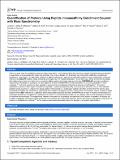| dc.contributor.author | Zhao, Lei | |
| dc.contributor.author | Whiteaker, Jeffrey R. | |
| dc.contributor.author | Pope, Matthew E. | |
| dc.contributor.author | Kuhn, Eric | |
| dc.contributor.author | Jackson, Angela | |
| dc.contributor.author | Anderson, N. Leigh | |
| dc.contributor.author | Pearson, Terry W. | |
| dc.contributor.author | Paulovich, Amanda G. | |
| dc.contributor.author | Carr, Steven A | |
| dc.date.accessioned | 2014-09-16T19:58:33Z | |
| dc.date.available | 2014-09-16T19:58:33Z | |
| dc.date.issued | 2011-07 | |
| dc.identifier.issn | 1940-087X | |
| dc.identifier.uri | http://hdl.handle.net/1721.1/89657 | |
| dc.description.abstract | There is a great need for quantitative assays in measuring proteins. Traditional sandwich immunoassays, largely considered the gold standard in quantitation, are associated with a high cost, long lead time, and are fraught with drawbacks (e.g. heterophilic antibodies, autoantibody interference, 'hook-effect').1 An alternative technique is affinity enrichment of peptides coupled with quantitative mass spectrometry, commonly referred to as SISCAPA (Stable Isotope Standards and Capture by Anti-Peptide Antibodies).2 In this technique, affinity enrichment of peptides with stable isotope dilution and detection by selected/multiple reaction monitoring mass spectrometry (SRM/MRM-MS) provides quantitative measurement of peptides as surrogates for their respective proteins. SRM/MRM-MS is well established for accurate quantitation of small molecules 3, 4 and more recently has been adapted to measure the concentrations of proteins in plasma and cell lysates.5-7 To achieve quantitation of proteins, these larger molecules are digested to component peptides using an enzyme such as trypsin One or more selected peptides whose sequence is unique to the target protein in that species (i.e. "proteotypic" peptides) are then enriched from the sample using anti-peptide antibodies and measured as quantitative stoichiometric surrogates for protein concentration in the sample. Hence, coupled to stable isotope dilution (SID) methods (i.e. a spiked-in stable isotope labeled peptide standard), SRM/MRM can be used to measure concentrations of proteotypic peptides as surrogates for quantification of proteins in complex biological matrices. The assays have several advantages compared to traditional immunoassays. The reagents are relatively less expensive to generate, the specificity for the analyte is excellent, the assays can be highly multiplexed, enrichment can be performed from neat plasma (no depletion required), and the technique is amenable to a wide array of proteins or modifications of interest.8-13 In this video we demonstrate the basic protocol as adapted to a magnetic bead platform. | en_US |
| dc.description.sponsorship | National Cancer Institute (U.S.) (NCI Clinical Proteomic Technology Assessment Center (CPTAC) grant (#U24 CA126476)) | en_US |
| dc.description.sponsorship | Entertainment Industry Foundation (grant) | en_US |
| dc.description.sponsorship | Entertainment Industry Foundation (EFI Women's Cancer Research Fund to the Breast Cancer Biomarker Discovery Consortium) | en_US |
| dc.description.sponsorship | W. M. Keck Foundation | en_US |
| dc.description.sponsorship | Canary Foundation | en_US |
| dc.description.sponsorship | Paul G. Allen Family Foundation | en_US |
| dc.language.iso | en_US | |
| dc.publisher | MyJoVE Corporation | en_US |
| dc.relation.isversionof | http://dx.doi.org/10.3791/2812 | en_US |
| dc.rights | Creative Commons Attribution | en_US |
| dc.rights.uri | http://creativecommons.org/ | en_US |
| dc.source | MyJoVE Corporation | en_US |
| dc.title | Quantification of Proteins Using Peptide Immunoaffinity Enrichment Coupled with Mass Spectrometry | en_US |
| dc.type | Article | en_US |
| dc.identifier.citation | Zhao, Lei, Jeffrey R. Whiteaker, Matthew E. Pope, Eric Kuhn, Angela Jackson, N. Leigh Anderson, Terry W. Pearson, Steven A. Carr, and Amanda G. Paulovich. “Quantification of Proteins Using Peptide Immunoaffinity Enrichment Coupled with Mass Spectrometry.” JoVE no. 53 (2011). | en_US |
| dc.contributor.department | Koch Institute for Integrative Cancer Research at MIT | en_US |
| dc.contributor.mitauthor | Carr, Steven A. | en_US |
| dc.relation.journal | Journal of Visualized Experiments | en_US |
| dc.eprint.version | Final published version | en_US |
| dc.type.uri | http://purl.org/eprint/type/JournalArticle | en_US |
| eprint.status | http://purl.org/eprint/status/PeerReviewed | en_US |
| dspace.orderedauthors | Zhao, Lei; Whiteaker, Jeffrey R.; Pope, Matthew E.; Kuhn, Eric; Jackson, Angela; Anderson, N. Leigh; Pearson, Terry W.; Carr, Steven A.; Paulovich, Amanda G. | en_US |
| dc.identifier.orcid | https://orcid.org/0000-0002-7203-4299 | |
| mit.license | PUBLISHER_CC | en_US |
| mit.metadata.status | Complete | |
